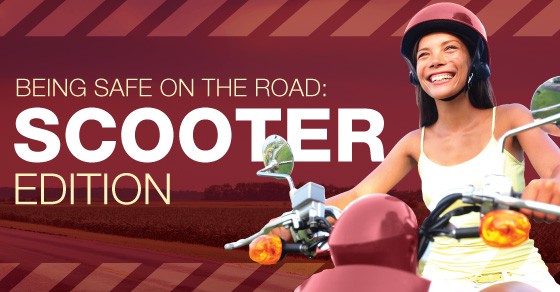Spend any time driving the streets of Evansville and you will most likely see at least one scooter sharing the road with you. Common and popular in cities around the country (and the world), scooters are an inexpensive alternative form of transportation – small, light, and economical. For individuals who choose not to take on the expense of an automobile, with maintenance, insurance, and fuel costs, a scooter is an appealing option.

But the differences between scooters and automobiles are the main reason that scooter riders must exercise caution when sharing the road. A scooter does not have the advantages of a “crumple zone” or airbags or seat belts – all standard features on automobiles. Never forget that an automobile is bigger, faster, and more powerful than most scooters out on the road.
Though the National Highway Traffic Safety Administration (NHTSA) does not separate scooters from the larger and more powerful motorcycles in its fatality reports, the statistics are significant: motorcyclists accounted for 15% of all traffic fatalities in 2012, and are 26 times more likely than automobile passengers to die in a traffic crash.
What is a Scooter?
The United States Department of Transportation (USDOT) defines a scooter as a motorcycle that has a platform or footrest for the operator’s feet, and a step-through architecture. Typically a scooter’s engine is beneath and to the rear of the operator, and the operator is in a perpendicular position to the seat.
Scooter Safety Starts With the Driver
Because a scooter doesn’t have the built-in protections that an automobile has, scooter operators have a greater responsibility to travel safely. The Motorcycle Safety Foundation (MSF) has developed a system designed to assist riders in becoming safer on the road, regardless if they’re riding a scooter or a more powerful motorcycle. MSF’s SEE system encourages motorcyclists and scooter riders to develop a heightened awareness while riding, helping them to respond to potentially dangerous situations on the road. The SEE acronym indicates the three steps of this system: Search, Evaluate, and Execute.
- Search – a consistent and constant scanning of the roadway and traffic
- Evaluate – assess conditions with an eye toward the worst-case scenario
- Execute – take appropriate action if needed
Scooter Safety Equipment
Safe scootering is more than mental preparedness, however. It also takes proper protective equipment and adherence to traffic rules. This includes:
- Helmet – Probably the most important piece of equipment you’ll need to protect yourself on a scooter. The most devastating and difficult injury to recover from is a Traumatic Brain Injury, and a helmet can help to mitigate that risk. Do your research and purchase the right helmet for your needs.
- Protective gear – In addition to a helmet, you’ll want to protect the rest of your body with goggles or shatterproof sunglasses, a riding jacket, pants, and proper footwear. All of this gear will help to protect your body from a serious case of road rash (or worse) if you’re involved in an accident.
- Visibility – “I didn’t see him” is a common statement given to law enforcement officers investigating an accident. Making yourself visible through the use of bright colors and reflective materials helps to increase your safety on the road.
- Rules of the road – Even though a scooter is smaller and lighter than most other vehicles on the road, riders must abide by the same traffic rules as everyone else. This means proper use of directional signals, controlling your speed, and using road lanes as they are designed to be used.
You’ll see many scooter riders in Evansville flaunting many of these guidelines, but understand that they are doing it at their own risk. An unprotected rider who doesn’t make himself visible to other vehicles is often the one who doesn’t walk away from an accident.
Scooter Laws in Indiana
If you ride a scooter in Evansville, you might be aware that the laws for scooter riders have changed recently. House Bill 1343, also known as “The Scooter Bill” took effect January 1, 2015, and provides local law enforcement as well as the driving public a set of rules for the operation of scooters on public roads.
Under the law, all scooter operators must register their vehicle with the BMV and purchase a license plate, regardless of engine size. However, there are some differences in operator and insurance requirements based on engine size:
- Scooters with an engine size of over 50cc are considered “Class A” vehicles
- Must purchase license plate
- Must have a valid driver’s license with a motor-driven cycle endorsement
- Must have insurance
- Can have passengers
- Riders under age 18 must have protective headgear and goggles
- Scooters with an engine size less than 50cc are considered “Class B” vehicles
- Must purchase license plate
- Must be at least 15 years of age and possess a valid Indiana ID
- Pass a written test at the BMV for a motor-driven cycle endorsement
- No insurance requirement
- Can NOT have passengers
- Riders under age 18 must have protective headgear and goggles
Reactions to this new law by the driving public were mixed, but the Evansville Police Department supported this legislation, primarily because of the licensing requirement. Police can track a registered scooter more easily when it is stolen if it has a license. This caused a nearly 300% drop in scooter thefts between 2014 and 2015.
Still, regardless of whether you’re driving a Class A or Class B scooter, your first priority should be a safe operation. Remember, you are the one most responsible for your own safety on a scooter.
If you or a loved one have been injured in a scooter accident, you may benefit from talking with an attorney experienced in accidents involving motorcycles. Your attorney will examine the facts of the situation and help you to determine what steps you should take to preserve your legal rights.
Contact Gerling Law for more information – it won’t cost you anything to see if we can help!

